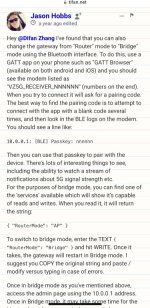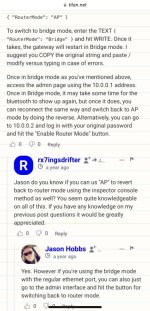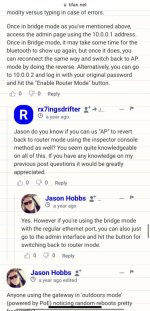Is anyone familiar with the “new” Verizon 5g home internet gateway (LVSKIHP)??
They seemed to have gone to great lengths to limit user access on the device’s web GUI. There’s no option to put the device into bridge mode. There’s no pass through. DMZ seems only to bypass certain router functions (maybe the firewall?), but not NAT itself. And though I’ve yet to try my luck with port forwarding, (I’m not well versed enough in that arena and I’m exhausted from trial and error in other areas only to figure out that what limited customization we’re given access to doesn’t end up behaving in ways that comport to our expectations )
Does anyone have a good resource you can point me to that explains the basics of port fwding or provides instructions on port forwarding to resolve double NAT issues?
or does anyone know how to SSH into this gateway who could tell me what I need to do to force the thing into bridge mode?
or other suggestions? (Are there other Verizon 5g mmW modems that allow you to switch to bridge mode? Customer service is useless. Their big suggestion is to google answers to my issues. Or call the sales people if I want to compare modem tech specs. Yikes.)
Apparently, an earlier version of this gateway’s firmware had allowed you to switch to bridge mode. But then they locked that ish down in the latest updates. (?)
I’m in my 30 day free trial period right now. And I’d love to be able to keep this, because it’s blazing fast and plans are cheap (especially if you have a Verizon cell phone too) and right now my rate is locked in for 10 YEARS if I keep it.
thank you!!
They seemed to have gone to great lengths to limit user access on the device’s web GUI. There’s no option to put the device into bridge mode. There’s no pass through. DMZ seems only to bypass certain router functions (maybe the firewall?), but not NAT itself. And though I’ve yet to try my luck with port forwarding, (I’m not well versed enough in that arena and I’m exhausted from trial and error in other areas only to figure out that what limited customization we’re given access to doesn’t end up behaving in ways that comport to our expectations )
Does anyone have a good resource you can point me to that explains the basics of port fwding or provides instructions on port forwarding to resolve double NAT issues?
or does anyone know how to SSH into this gateway who could tell me what I need to do to force the thing into bridge mode?
or other suggestions? (Are there other Verizon 5g mmW modems that allow you to switch to bridge mode? Customer service is useless. Their big suggestion is to google answers to my issues. Or call the sales people if I want to compare modem tech specs. Yikes.)
Apparently, an earlier version of this gateway’s firmware had allowed you to switch to bridge mode. But then they locked that ish down in the latest updates. (?)
I’m in my 30 day free trial period right now. And I’d love to be able to keep this, because it’s blazing fast and plans are cheap (especially if you have a Verizon cell phone too) and right now my rate is locked in for 10 YEARS if I keep it.
thank you!!




